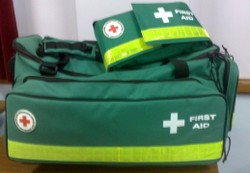Safety is deeply ingrained in us. So deeply that we don't see it. We see the safety regulations and the government requirements but we don't examine the deeper causes of those often vague and confusing piles of paper.
It's almost a case of the Emperor's New Clothes.
So let's take our suit off and examine it.

Safety Suit
by Fargy
We wear personal protective equipment, but there is more to safety when we suit up.
Suit up!
Safety, the new frontier, timidly we go, so that nobody else has to.
To give us a little more confidence we suit up to hopefully prevent some piece of chaos hitting us and damaging us.
And that suiting up can take various forms. We like to fit in, we feel safer fitting in. Even if that fitting in is in bikie colours. Or perhaps a police uniform. Even as adults we play dress-up. Children play dress-up because they copy us. We play cops and robbers with our different uniforms because we feel safer belonging, and visual identification of others that are the same as us is very important to us, because feeling safe is important to us.
Confidence is part of safety. If we do not fear the danger, if the risk is controlled, we are more confident.
One of our greatest fears is communicating.
We fear public speaking, the danger is that we will be judged and rejected.
Yet we need to communicate to improve Safety.
We need to dress accordingly, in effect it's safety gear, it helps prevent bad judgement of us. If in a business arena we dress professionally. We want to allay fears in our audience.
The audience will need assurance that what we say can be trusted. Their risk is that they pay money for something that won't help them.
In less than 30 seconds you will be judged. What we wear and our deportment are primarily how we are judged. This judgement is primal, and one day we may get past this need to instantly quantify. However, that day is not this day.
For more reading on how we instantly judge...
It is more than what you wear though. A confident presentation inspires confidence.
One way to be confident is to know your material. Be factual.
Information connects with people in a more adult way.
So if you can explain why a certain improvement to safety is needed because a certain task has a statistically significant risk, then those who listen will be able to cost the risk, and that will help them communicate the issue on to their superiors.
They need to feel confident that they can spread your message confidently.
Get people to say your message back to you. Let them practice on you, ask them what your message is.
And there we have it...
1. Suit up to get you past the initial judgement barrier.
2. Study up to provide content.
3. Loop the message to ensure that content was received.
This is extremely important.
To keep people safe, we need to talk.
And talking is a danger, it's why we are afraid of it, so please wear your personal protective equipment.
Other articles by the author.
You might also like
First Aid: Would you Know What to Do?A medical emergency could happen at any moment. The question is whether you h...









 We are always wrongon 12/12/2014
We are always wrongon 12/12/2014
 Conspiracies are Realon 03/24/2014
Conspiracies are Realon 03/24/2014
 Workout for the Doleon 02/26/2014
Workout for the Doleon 02/26/2014
 Fiery New Brands for Aussie politicson 02/25/2014
Fiery New Brands for Aussie politicson 02/25/2014

Comments